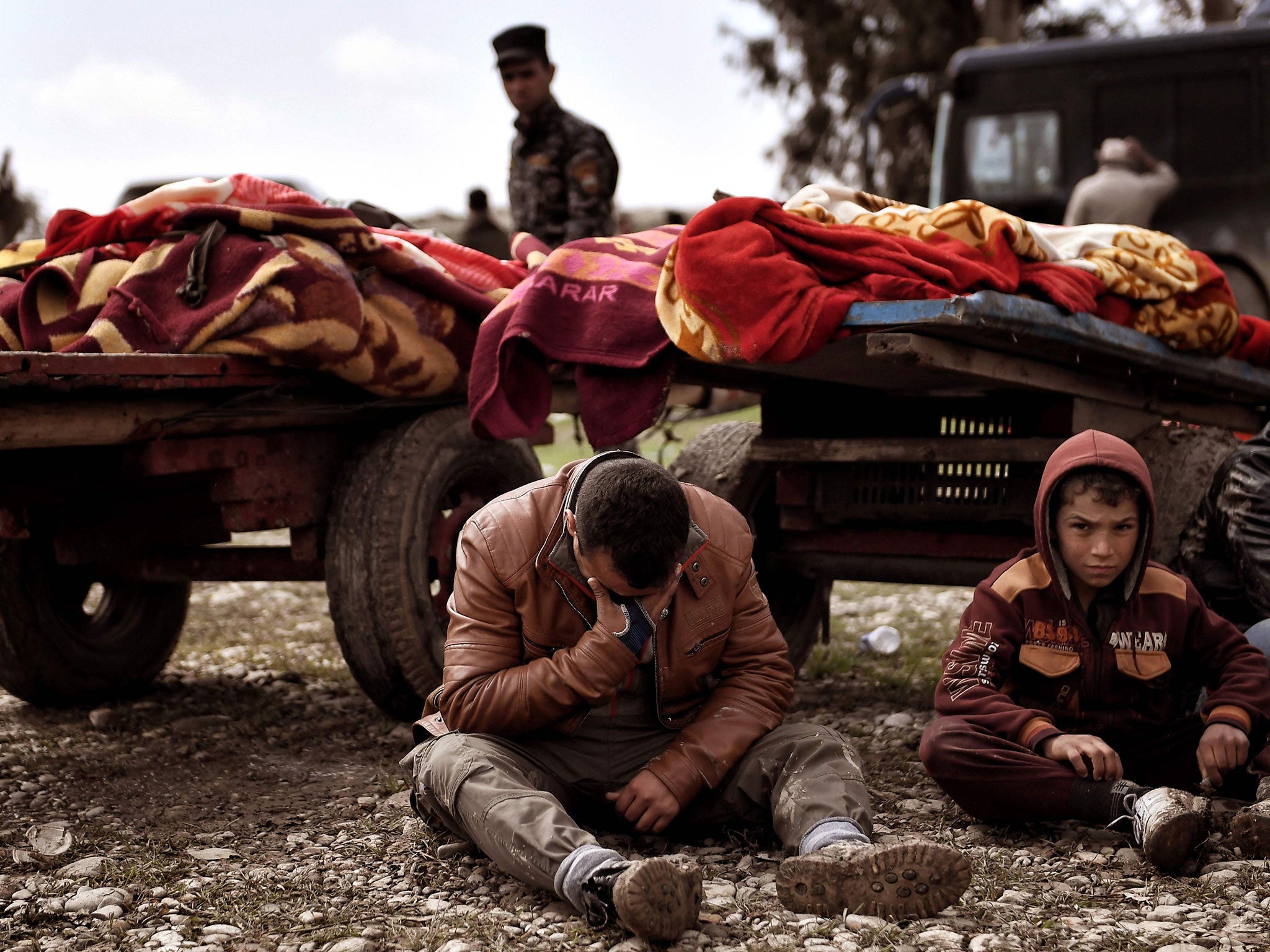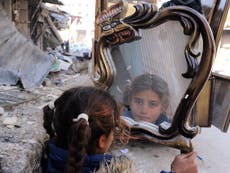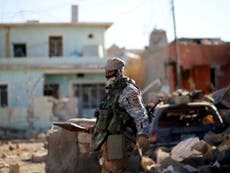Air strikes are the only way to defeat Isis? Then tell the truth about the loss of civilian life
More can be done for residents of Mosul not to become victims of bombs targeting Isis – and more should be done to report with candour


Standing high above Mosul beside the ruins of the Nabi Yunus shrine, destroyed by Isis as idolatrous in 2014, one can see the west of the city on the far side of the Tigris River. There the Iraqi security forces and Isis are engaged in the fiercest and longest battle of the Iraq conflict. Like many battlefields, the scene is eerily pretty as spring rains turn the trees and grass a fresh green colour, and buildings are too distant to tell if they have been damaged or destroyed.
A single large column of black smoke and three smaller plumes of white smoke rise over west Mosul, but do not look very menacing. There is the crash of an artillery piece firing close by and, a few seconds later, another wisp of smoke or dust appears on the other side of the city. Isis mortar teams periodically fire in our direction and we visit the Nabi Yunus covered market where earlier a round hit a shop selling perfume which exploded into flames, killing 11 adults and a child.
In modern war, every bombardment of a city from ground and air is different, but the justification by politicians and military commanders is usually much the same. Those ordering the air, missile or artillery attacks emphasise the meticulous care they take to avoid civilian casualties and, if these inadvertently occur, it is only because of the devilish practices of the other side who are using ordinary folk as human shields. Much the same lies were used to justify the Israeli bombardment of Lebanon in 1982, 1996 and 2006 and of Gaza in 2008, 2009 and 2014; the American bombing of Iraq in 1991 and 2003; the Syrian government levelling of whole towns since 2011 and the Russians doing much the same since they intervened in Syria in 2015.
In all cases, if you bomb an area containing both combatants and civilians you will kill many of the latter, because you can never distinguish sufficiently between the two, even if that was not your original intention.
The grisly tradition of trying to explain away heavy civilian loss of life caused by aerial and artillery bombardment of cities is being maintained by the US-led air coalition and Iraqi government during the siege of Mosul.
Once again, the propaganda myth that “surgical strikes” can distinguish the innocent from the guilty has been pumped out. But what counts is the accuracy not only of the weapons, but of the information about who is going to be on the receiving end – something which, in the chaos of war, is always inadequate.
People in flight from Mosul are caustic about Iraqi and US claims about the accuracy of their weapons. Mohammed Ali Suleiman, a 66-year-old shopkeeper, said “they talk about ‘smart bombs’ but my neighbourhood is 90 per cent destroyed by them”. Jasim, living inside an Isis-held area near the Old City, was badly wounded in the lower leg by a bomb dropped by a drone because he had not heard that the Iraqi military and the US air controllers regard the use of canvas to cover cars or roofs as a sure sign that Isis is hiding a fighting position or arms dump.
Isis snipers are killing anybody who tries to leave west Mosul because they do not want to lose their “human shields” but even if they did not do so, a proportion of the civilian population would stay behind and be targeted along with Isis fighters. Unexplained is why the Baghdad government at first urged civilians in Mosul to stay in their homes, though this played into the hands of Isis. Somebody grossly underestimated the strength of Isis resistance, or did not want to cope with a million displaced people, or had foolish and romantic ideas about a popular uprising against Isis.
The obvious falsehood that a bombardment can be conducted in a confined area where civilians are present without killing a lot of them has a quite limited sell-by date. Israelis, Americans, Syrians, Russians and Iraqis have all, at different times, responded to mass killings for which they are being blamed by a flat denial that it happened at all, by stating that it was not as large as reported or that somebody else is responsible. Where the evidence is incontrovertible, the aim is to muddy the waters until the news agenda has moved on. An old PR adage about how to deal with damaging news advises those rebutting it “to first say ‘no story’ and then say ‘old story’"; this works well in most cases.
The problem is that, in the case of bombing campaigns, disaster is always just around the corner. A sympathetic media generally goes along with the pretence that bombing and shelling is more discriminating than it really is and plays down evidence to the contrary. But this just stores up trouble for the future when calamity finally strikes – as it always does – and denials and evasions simply underline the guilt of the perpetrator.
I remember during the American-led air campaign in Baghdad in 1991 visiting a bombed baby milk factory at Abu Ghraib, which the US insisted had produced biological weapons. I was there soon after the attack and there was no doubt that it had, indeed, once produced baby milk, though it appeared to have gone out of business. I found a smashed desk with a drawer full of angry letters from creditors. So far as I recall, it emerged long after that the US had probably bombed the factory because they had spotted a piece of camouflage netting there similar to that used at other facilities they were sure were producing biological weapons.
The bombing of buildings in the al-Jadida district of east Mosul on 17 March, which may have killed as many as 240 people, is the present day equivalent of the Abu Ghraib factory a quarter of a century ago. The Iraqi civilian and military authorities have responded with an unconvincing scatter-gun of contradictory counter allegations of the type one has so often heard in the past from Israelis, Americans, Russians and Syrians. They suggestion is that only 61 people died and Isis had packed the walls of the building with explosives or left a giant suicide bomb outside it.
Governments are commonly hypocritical and mendacious about the effect of bombing campaigns carried out in their name, but it is too easy for the media to be holier than thou. The Iraqi government and its allies are right to try to recapture Mosul in order to destroy Isis, a movement of monstrous evil which has murdered, raped and enslaved.
In practice, there is no way of defeating its fanatical fighters in the city without using airstrikes and artillery fire in support of ground troops. The mistake is not in the use of these weapons, but in failing to admit their indiscriminate nature or get civilians out of Mosul before they were used.



Join our commenting forum
Join thought-provoking conversations, follow other Independent readers and see their replies